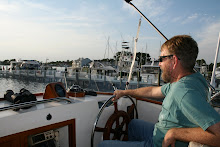Man, I hate to admit this. But I've got a bird problem directly related to the
Betty Jane. Most folks are familiar with the Great Blue Heron (photo to come), a rather large winged specimen that ordinarily hangs tight with swampy, woodsy locations. Myself? I've always been a fan of the Great Blue. His presence typically signifies the wiles of nature, a favorite destination
pour mois.
However, over the past couple of weeks, a Great blue my my wife and I have taken to calling G.B. has developed a great affection for
Betty and, from everything I can tell, taken over semi-possession of her, at least in his own mind.
Just this past weekend BJ and I were preparing to embark on a Sunday mini-cruise, me outside the boat on the port walkway and BJ inside the boat stowing stuff, when G. B. materialized on the fingerpier adjacent to our starboard side.
"Bill," BJ intoned ominously, while eyeing the giant avian aviator who was eyeing her back through a side window, "There's a big bird on the dock...and I mean BIG!"
"What," I asked, reasonably.
"A big bird and he looks...I mean I think he means business."
"What," I asked again, still reasonably, while strolling around the bow to come down the starboard side. What I saw put the fear of the Bird Gods in me. Our Great Blue was easily four-foot tall, maybe even five-foot tall with his neck fully extended. He had a menacing, rapier-like beak that was about one-foot long, and he had an exceptionally displeased (or was it just quizzical) expression upon his face. "Hey, buddy, this here's my territory...what the heck you doin' on MY territory," the look seemed to say.
Shoving off was a tad difficult. And ultimately I had to pluck up the nerve to get out onto the fingerpier with G.B., who gave way grudgingly, but not by much. Talk about profiles in courage. To deal with the shorepower cord I had to bend over and place my
derriere right on the firing line, at a range of less than two feet, with my wife fretting from the cockpit, "Oh Bill he's coming toward you...he's coming toward you."
All went smoothly, though. And as we pulled away from the slip, G.B stood there watching us, doing a slow burn or at least what seemed like a slow burn.
Coming back to the dock after the mini-cruise I had one overriding thought: Jeeze, I hope the ol' boy's moved on. And indeed, while backing into the slip I noticed the absence of G.B. with deep gratitude. We tied up without incident and I commenced washing down with a bucket, hose, deck brush and a couple of mitts I use to do the rails. All was wondrous. I love to whistle and sing while I work so I began cheerily singing and whistling.
But then came the dreaded return. Toward the end of the washdown process it occurred to me that I might as well fill the water tank before taking the hose off the boat. The task's a worshippy one, from the standpoint of posture. While removing the fill cap from its fitting in the cockpit sole with a spanner I am constrained to kneel on the deck with my back to
Betty's forward portions.
"Hmmmm...hmmmmm....hhhhhmmmmmmmmmmm, I chortled while cranking away on the spanner.
Maybe G.B. is a music lover--I don't know. Anyway, he secretly hopped aboard from some undisclosed location and, intrigued by the siren song no doubt, made his way slowly and stealthily down the starboard side deck. I was oblivious to this, of course, and so was BJ, who was reading the
New York Times in the saloon and grousing about Congress.
"Squawwwwwwwkkkkkkk," proclaimed G.B. with considerable aggression (to get a handle on the audio here, check out:
http://www.birds.cornell.edu/AllAboutBirds/BirdGuide/Great_Blue_Heron_dtl.html#sound), while peering dolefully around the corner. His warning shot took me by such immense surprise that I launched from the kneeling position into full aeronautical mode in under a millisecond. Whaaaaaa!!!!!!! As luck would have it, the taffrail that spans
Betty's transom kept me from actually leaving the cockpit via the power of fright. Unperturbed, G.B. hopped off onto the fingerpier and stalked off to glare from a modest remove.
"We're gonna have to make friends with him," observed BJ. She'd just opened the door from the saloon into the cockpit upon hearing the commotion. G.B. switched his gaze to her and blinked, going for sympathy, I'd say.
"Yeah," I panted, waiting for my heart to quit racing, "Maybe bait fish'll have a soothing effect on him. If not, I'm gonna have to start doin' tranquilizers to survive the marine scene around here."




































